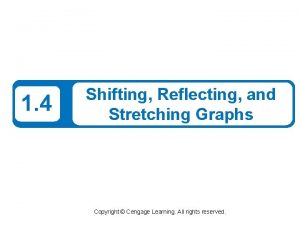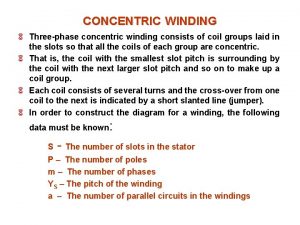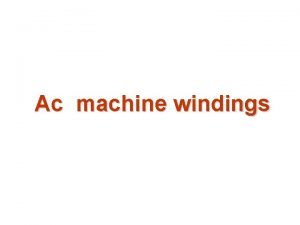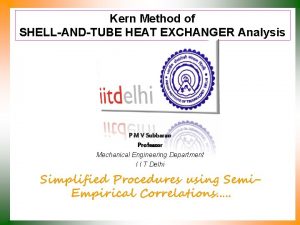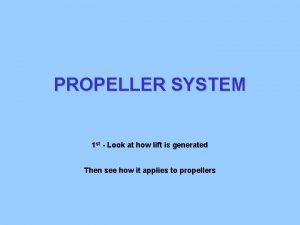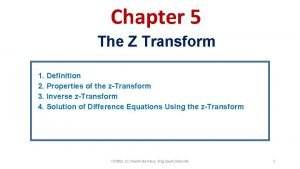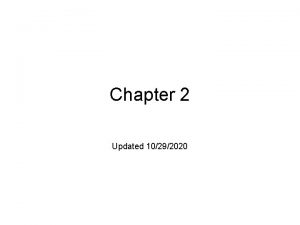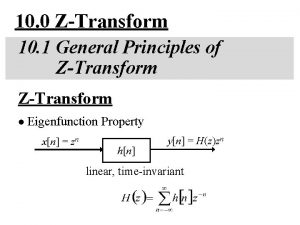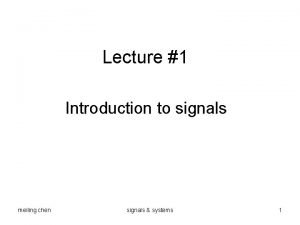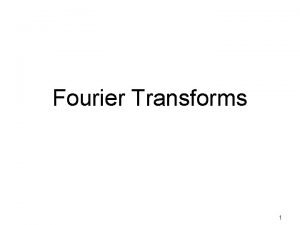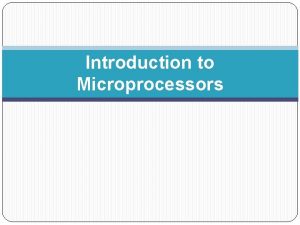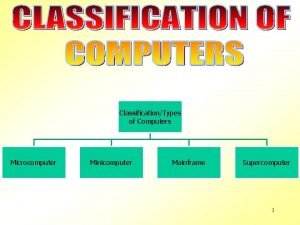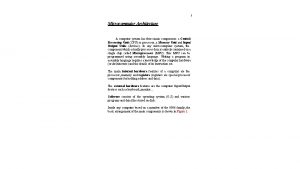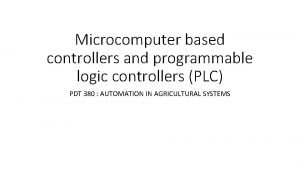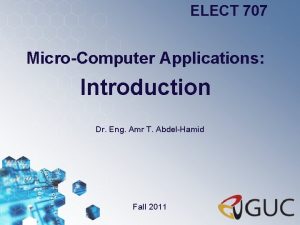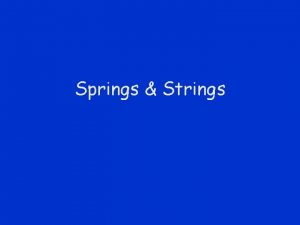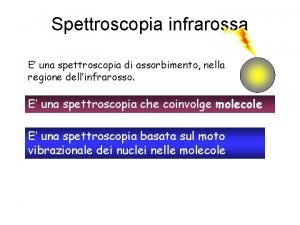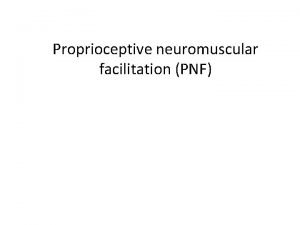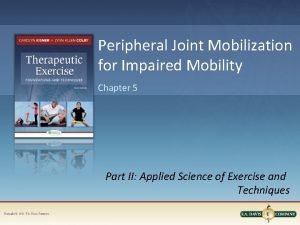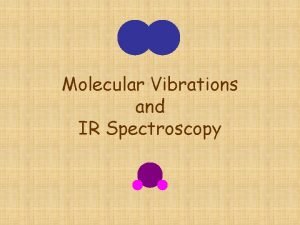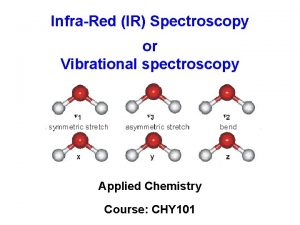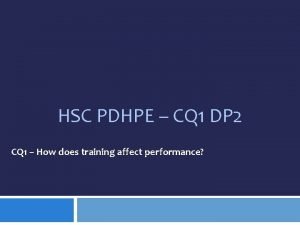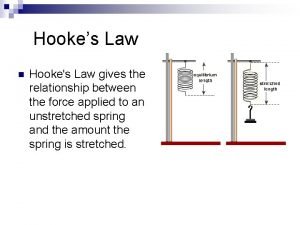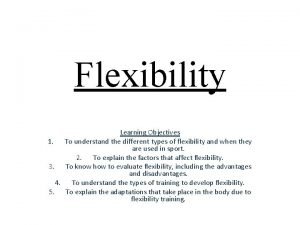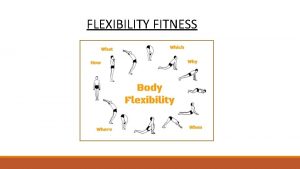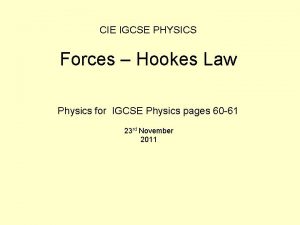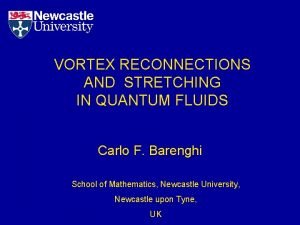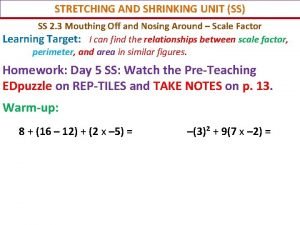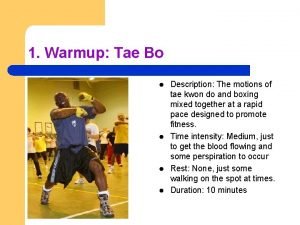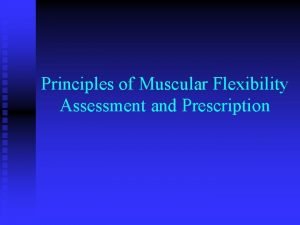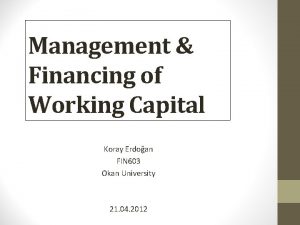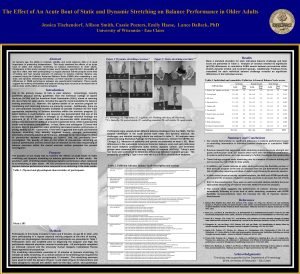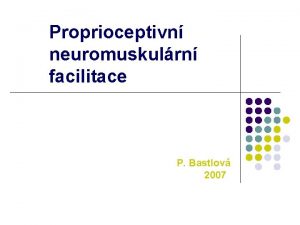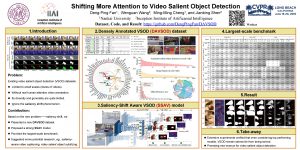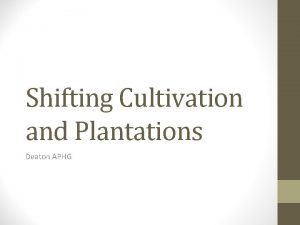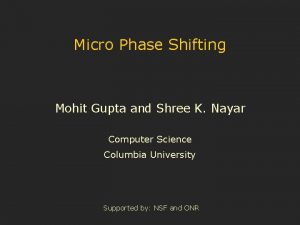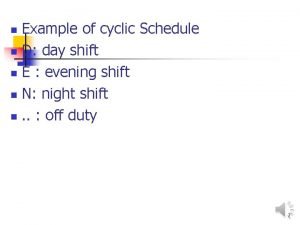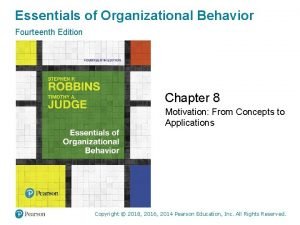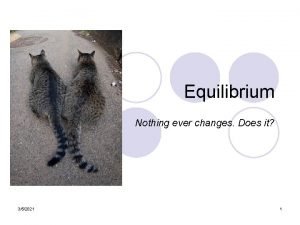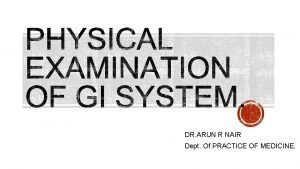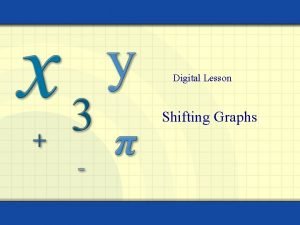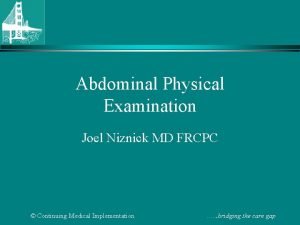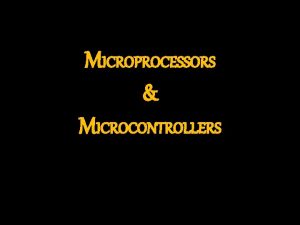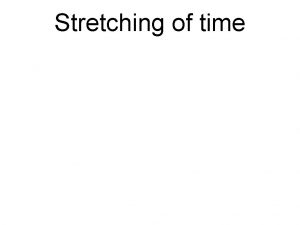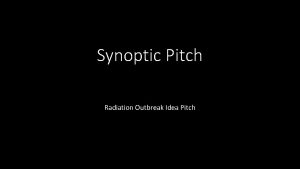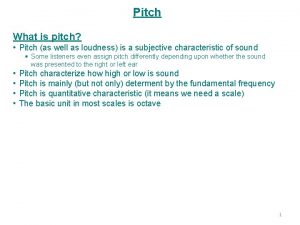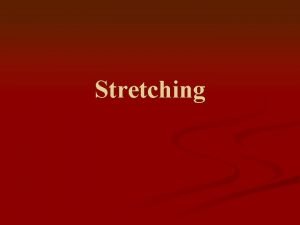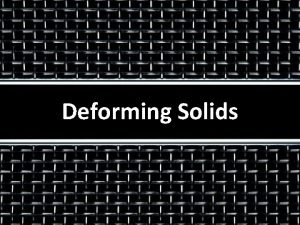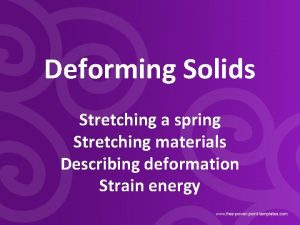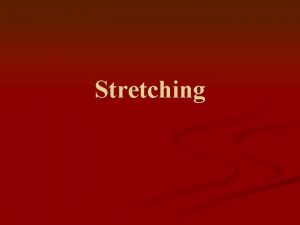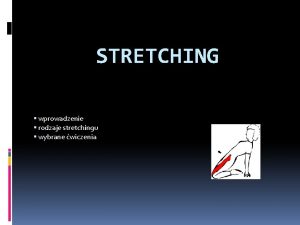Microcomputer Systems 2 Time Stretching Pitch Shifting of





































































- Slides: 69

Microcomputer Systems 2 Time Stretching & Pitch Shifting of Audio Signals Veton Këpuska

Time Stretching & Pitch Shifting of Audio Signals Outline Introduction Techniques Used for Time Compression/Expansion and Pitch Shifting Comparison Timbre and Formants Veton Këpuska

Outline Introduction u Frequency Shift vs. Pitch Shift – Audio Examples Time Compression/Expansion n n Techniques Used for Time Compression/Expansion and Pitch Shifting u The Phase Vocoder n u u Related Topics Why Phase Time Domain Harmonic Scaling (TDHS) More recent approaches n n Comparison u Which Method to Use Pitch Shifting Considerations Audio Examples n n n Timbre and Formants u n n 11/25/2020 Phase Vocoder and Formants Time Domain Harmronic scaling and Formants Veton Këpuska 3

Introduction u Time Stretching & Pitch Shifting n n Are two dominant techniques that used for speech and sound manipulation. Typical applications entail: u u 11/25/2020 Changing the speed of play-back (altering the length of the signal) without altering the pitch of the voice and/or instruments Changing the pitch of the voice and/or instruments without changing the length of the signal. Veton Këpuska 4

Pitch Shifting Veton Këpuska

Pitch Shifting: u u As opposed to the process of pitch transposition achieved using (a simple) sample rate conversion, Pitch Shifting is a way to change the pitch of a signal without changing its length. In practical applications, this is usually achieved by changing the length of a sound using one of the methods discussed next and then performing a sample rate conversion to change the pitch. 11/25/2020 Veton Këpuska 6

Introduction u Pitch Shifting is NOT Frequency Shifting: n There exists a certain confusion in terminology in the literature, as Pitch Shifting is often also incorrectly named 'Frequency Shifting'. u u n A true Frequency Shift (as obtainable by modulating an analytic signal by a complex exponential) will shift the spectrum of a sound, while Pitch Shifting will dilate it, upholding the harmonic relationship of the sound. Frequency Shifting yields a metallic, inharmonic sound which may well be an interesting special effect but which is a totally inadequate process for changing the pitch of any harmonic sound except a single sine wave. 11/25/2020 Veton Këpuska 7

Audio Examples of Pitch Shifting vs. Frequency Shifting u Original Sound: u Pitch Shifted: u Frequency Shifted: 11/25/2020 Veton Këpuska 8

Time Compression/Expansion Veton Këpuska

Time Compression/Expansion u Time Compression/Expansion, also known as "Time Stretching" is the reciprocal process to Pitch Shifting. n n It leaves the pitch of the signal intact while changing its speed (tempo). This is a useful application when you wish to change the speed of a voiceover without messing with the timbre of the voice. 11/25/2020 Veton Këpuska 10

Time Compression/Expansion u There are several fairly good methods to do time compression/expansion and pitch shifting but most of them will not perform well on all different kinds of signals and for any desired amount of shift/stretch ratio. u Typically, good algorithms allow pitch shifting up to 5 semitones on average or stretching the length by 130%. u When time stretching and pitch shifting single instrument recordings you might even be able to achieve a 200% time stretch, or a one-octave pitch shift with no audible loss in quality. 11/25/2020 Veton Këpuska 11

Time Compression/Expansion of Speech u Typical Goals n u To either speed up or slow down a speech signal while maintaining the approximate pitch Applications n n Change voice mail playback Court stenographers-play proceedings quicker Sound effects Etc… 11/25/2020 Veton Këpuska 12

Techniques Used for Time Compression/Expansion & Pitch Shifting u Option 1 – Change sample rate n u If you modify the sample rate, you can change the speed but the pitch is also changed u Increase sample rate = higher pitch (chipmunk sound) u Decrease sample rate = lower pitch (drawn out echo sound) Option 2 – Decimate or Interpolate Signal n If you change the number of samples, the result is the same as modifying the sample rate 11/25/2020 Veton Këpuska 13

Techniques Used for Time Compression/Expansion & Pitch Shifting u Option 3 – Use more complex methods n This will change the speed of the sample while preserving the pitch data u u 11/25/2020 Short Time Fourier Transform Magnitude Sinusoidal Synthesis Linear Prediction Synthesis Veton Këpuska 14

Techniques Used for Time Compression/Expansion & Pitch Shifting u Currently, there are two different principal time compression/expansion and pitch shifting schemes employed in most of today's applications: n n Phase Vocoder. Time Domain Harmonic Scaling (TDHS). 11/25/2020 Veton Këpuska 15

Phase Vocoder Veton Këpuska

Phase Vocoder u Phase Vocoder. This method was introduced by Flanagan and Golden in 1966 and digitally implemented by Portnoff ten years later. n n Portnoff, M. R. 1981 a. "Short-Time Fourier Analysis of Sampled Speech. " IEEE Transactions on Acoustics, Speech and Signal Processing ASSP-29(3): 364 -373. Portnoff, M. R. 1981 b. "Time-Scale Modification of Speech Based on Short. Time Fourier Analysis. " IEEE Transactions on Acoustics, Speech and Signal Processing ASSP-29(3): 374 -390. 11/25/2020 Veton Këpuska 17

Phase Vocoder u u It uses a Short Time Fourier Transform (use abbreviation STFT from here on) to convert the audio signal to the complex Fourier representation. Since the STFT returns the frequency domain representation of the signal at a fixed frequency grid, the actual frequencies of the partial bins have to be found by converting the relative phase change between two STFT outputs to actual frequency changes. Note the term 'partial' has nothing to do with the signal harmonics. In fact, a STFT will never readily give you any information about true harmonics if you are not matching the STFT length to the fundamental frequency of the signal – and even then is the frequency domain resolution quite different to what our ear and auditory system perceives. The timebase of the signal is changed by calculating the frequency changes in the Fourier domain on a different time basis, and then an i. STFT is done to regain the time domain representation of the signal. 11/25/2020 Veton Këpuska 18

Phase Vocoder u Phase vocoder algorithms are used mainly in scientific and educational software products (to show the use and limitations of the Fourier Transform) but have gained in popularity over the past few years due to improvements that made it possible to greatly reduce the artifacts of the "original" phase vocoder algorithm. u The basic phase vocoder suffers from a severe drawback because it introduces a considerable amount of artifacts audible as 'smearing' and 'reverberation' (even at low expansion ratios) due to the “non-synchronized vertical coherence of the sine and cosine basis functions” that are used to change the timebase. 11/25/2020 Veton Këpuska 19

Phase Vocoder u u Puckette, Laroche and Dolson have shown that the phasiness can be greatly reduced by picking peaks in the Fourier spectrum and keeping the relative phases around the peaks unchanged. Even though this improves the quality considerably it still renders the result somewhat phasey and diffuse when compared to time domain methods. Current research focuses on improving the phase vocoder by applying intra-frame sinusoidal sweep and ramp rate correction (Bristow-Johnson and Bogdanowicz) and multi-resolution phase vocoder concepts (Bonada). 11/25/2020 Veton Këpuska 20

Links to Publicly Available Vocoders u Pointers - Phase Vocoder: n n n n The MIT Lab Phase Vocoder Wave. Masher - GPL/Open Source Phase Vocoder by Kenneth Sturgis Sculptor: A Real Time Phase Vocoder by Nick Bailey A Phase Vocoder implementation using Matlab More reading on the Phase Vocoder The IRCAM "Super Phase Vocoder“ S. M. Bernsee's Pitch Shifting Using The Fourier Transform article (with C code) 11/25/2020 Veton Këpuska 21

Time Domain Harmonic Scaling (TDHS). Veton Këpuska

Time Domain Harmonic Scaling (TDHS). u Time Domain Harmonic Scaling (TDHS). This is based on a method proposed by Rabiner and Schafer in 1978. It is heavily based on a correct estimate of the fundamental frequency of the sound processed. 11/25/2020 Veton Këpuska 23

Theory u Short Time Fourier Transform Methods n n n Chapter 7 in our text (Discrete-Time Speech Signal Processing) Refer to notes from in class for mathematical theory of operation I will pick up from where Dr. Kepuska stopped in his notes 11/25/2020 Veton Këpuska 24

How is the Speech/Sound Signal Processed u Link: n Ch 7 -Short. Time_Fourier_Transform_Analysis_and_ Synthesis. ppt 11/25/2020 Veton Këpuska 25

Terminology & Basic Idea Frame Rate Window Size 11/25/2020 Veton Këpuska 26

Short Time Fourier Transform u Short Time Fourier Transform n n Also called the Fairbanks method Extract successive short-time segments and then discard the following ones Signal STFT Decimate Samples IFFT OLA 11/25/2020 Veton Këpuska Output 27

Short Time Fourier Transform u Frame Rate factor L n In frequency domain after taking the STFT, you get u n X(n. L, ω) Form a new signal by u Y(n. L, ω) = X(sn. L, ω) n u u where s = compression factor Take Inverse Fourier Transform Use Overlap and Add method to form new signal 11/25/2020 Veton Këpuska 28

Short Time Fourier Transform X(n. L, ω) Y(n. L, ω) = X(2 n. L, ω) 11/25/2020 Veton Këpuska 29

Short Time Fourier Transform New Sequence Original Windowed Sequence 11/25/2020 Veton Këpuska 30

Short Time Fourier Transform u Problems n Pitch Synchronization u It is highly likely that the pitch periods will not line up properly 11/25/2020 Veton Këpuska 31

Short Time Fourier Transform Magnitude u Short Time Fourier Transform Magnitude n Problems with STFT method relate directly to the linear phase component of the STFT u n Time shift = phase change Alternate approach is to only use the magnitude portion of the STFT—Short Time Fourier Transform Magnitude 11/25/2020 Veton Këpuska 32

Short Time Fourier Transform Magnitude u Compression n With the Fairbanks method, time slices were discarded Now we can just compress the time slices Form a new signal by u |Y(n. M, ω)| = |X(n. L, ω)| where n n 11/25/2020 M = compression factor = L / speed i. e. for speeding up by two => M = L/2 Veton Këpuska 33

Short Time Fourier Transform Magnitude u Compression n n Take Inverse Fourier Transform Use Overlap and Add method to form new signal 11/25/2020 Veton Këpuska 34

Short Time Fourier Transform Magnitude X(n. L, ω) Y(n. M, ω) = X(n. L, ω) M=L/2 11/25/2020 Veton Këpuska 35

Short Time Fourier Transform Magnitude New Sequence Original Windowed Sequence 11/25/2020 Veton Këpuska 36

Other Methods u Sinusoidal Synthesis—Chapter 9 n n n Time-warp the sinewave frequency track and the amplitude function This technique has been successful with not only speech but also music, biological, and mechanical signals Problems u u 11/25/2020 Does not maintain the original phase relations Suffer from reverberance Veton Këpuska 37

Other Methods u Linear Prediction Synthesis n n Use Homomorphic and Linear Prediction results to modify the time base Book briefly mentions this is possible but ran out of time before I could investigate this process more 11/25/2020 Veton Këpuska 38

Other Methods u New Techniques n u Internet search showed several methods trying to improve on what is out there now Software n n Different software programs that will change speed for you Adobe Audition is one of the most all encompassing right now 11/25/2020 Veton Këpuska 39

Matlab Code -Prepare the Workspace %%%%%%%% % Prepare Workspace %%%%%%%% close all; clear all; window_size_1 = 200; frame_rate_1 = 100; %Speed to slow down by speed = 2; 11/25/2020 Veton Këpuska 40

Matlab Code -Load the Speech Signal %%%%%%%% % Load Data File %%%%%%%% filename = input('Please enter the file name to be used. '); [sample_data, sample_rate, nbits] = wavread(filename); loop_time = floor(max(size(sample_data))/frame_rate_1); sample_data((max(size(sample_data))): (loop_time+1)* frame_rate_1)=0; 11/25/2020 Veton Këpuska 41

Matlab Code -Develop the Window %%%%%%%% % Create Windows %%%%%%%% % Want windows of 25 ms % File sampled at 10, 000 samples/sec % Want a window of size 10000 * 25 ms(10 ms) triangle_30 ms = triang(window_size_1); %triangle_30 ms = hamming(window_size_1); W 0 = sum(triangle_30 ms); 11/25/2020 Veton Këpuska 42

Matlab Code -Window the Entire Speech Signal %%%%%%%% % Window the speech %%%%%%%% for i =0: loop_time-1 window_data(: , i+1)=sample_data((frame_rate_1*i)+1: ((i+ 2)* frame_rate_1)). *triangle_30 ms; end 11/25/2020 Veton Këpuska 43

Matlab Code -Perform the Fast Fourier Transform %%%%%%%% % Create FFT %%%%%%%% for i = 1: loop_time window_data_fft(: , i) = fft(window_data(: , i), 1024); end 11/25/2020 Veton Këpuska 44

Matlab Code -Recreate the Modified Signal %%%%%%%% % Recreate Original Signal %%%%%%%% %Initialize the recreated signals reconstructed_signal(1: (loop_time+1)*frame_rate_1)=0; real_reconstructed_signal(1: (loop_time+1)*frame_rate_1)=0; modified_reconstructed_signal(1: (loop_time+3)*(frame_rate_ 1/speed))=0; modified_reconstructed_signal_compressed(1: (loop_time+3)* (frame_rate_1/ speed))=0; 11/25/2020 Veton Këpuska 45

Matlab Code -Recreate the Modified Signal % Perform the ifft for i = 1: loop_time recreated_data_ifft(: , i) = ifft(window_data_fft(: , i), 1024); real_recreated_data_ifft(: , i) = ifft(abs(window_data_fft(: , i)), 1024); truncated_recreated_data_ifft(: , i) = recreated_data_ifft(1: window_size_1, i). *(frame_rate_1/W 0) ; real_truncated_recreated_data_ifft(: , i) = real_recreated_data_ifft(1: window_size_1, i). *(frame_rate_1 /W 0); end 11/25/2020 Veton Këpuska 46

Matlab Code -Recreate the Modified Signal % Get back to the original signal for i=0: loop_time-1 reconstructed_signal((frame_rate_1*i)+1: ((i+2)*frame_rat e_1)) = reconstructed_signal((frame_rate_1*i)+1: ((i+2)*frame_rat e_1)) + truncated_recreated_data_ifft(: , i+1)'; real_reconstructed_signal((frame_rate_1*i)+1: ((i+2)*fram e_rate_1)) = real_reconstructed_signal((frame_rate_1*i)+1: ((i+2)*fram e_rate_1)) + real_truncated_recreated_data_ifft(: , i+1)'; end 11/25/2020 Veton Këpuska 47

Matlab Code -Recreate the Modified Signal % Get a modified signal by deleting certain parts (STFT) for i=0: (loop_time-1)/speed modified_reconstructed_signal((frame_rate_1*i)+1: ((i+2)* frame_rate_1)) = modified_reconstructed_signal((frame_rate_1*i)+1: ((i+2)*f rame_rate_1)) + real_truncated_recreated_data_ifft(: , i*speed+1)'; end 11/25/2020 Veton Këpuska 48

Matlab Code -Recreate the Modified Signal % Initialize the compressed sequence (STFTM) modified_reconstructed_signal_compressed(1: frame_rate_1+f rame_rate_1/speed+1)=truncated_recreated_data_ifft(fram e_rate_1 -frame_rate_1/speed: window_size_1, 1)'; % Get a modified signal by compressing for i=0: (loop_time-2) modified_reconstructed_signal_compressed((frame_rate_1/ speed*i)+1: (frame_rate_1/speed*i)+window_size_1) = modified_reconstructed_signal_compressed((frame_rate_1/ speed*i)+1: (frame_rate_1/speed*i)+window_size_1) + real_truncated_recreated_data_ifft(: , i+2)'; end 11/25/2020 Veton Këpuska 49

Matlab Code -Plot Results %%%%%%%% % Plot Results %%%%%%%% Figure; subplot(211) plot(sample_data) title('Original Speech'); v 1=axis; hold on; subplot(212) plot(real(modified_reconstructed_signal)) title(['STFT Synthesis w/ Speed = ', num 2 str(speed), 'X']); v 2=axis; if speed > 1 subplot(211); axis(v 1) subplot(212); axis(v 1) else subplot(211); axis(v 2) subplot(212); axis(v 2) end 11/25/2020 Veton Këpuska 50

Matlab Code -Write Sound Files %%%%%%%% % Write sound files %%%%%%%% wavwrite(modified_reconstructed_signal, sample_rate, nbits, 'C: ClassesECE_5525tea party fairbanks 2 x. wav') 11/25/2020 Veton Këpuska 51

Examples Baseline Samples Sample Rate 2 X STFT Sound file Sample Rate. 5 X STFTM Sound file Original File 11/25/2020 Veton Këpuska 52

Examples STFT—Speed 0. 5 X Sound file 11/25/2020 Veton Këpuska 53

Examples STFT—Speed 2 X Sound file 11/25/2020 Veton Këpuska 54

Examples STFT—Speed 4 X Sound file 11/25/2020 Veton Këpuska 55

Examples STFTM—Speed 0. 5 X Sound file 11/25/2020 Veton Këpuska 56

Examples STFTM—Speed 2 X Sound file 11/25/2020 Veton Këpuska 57

Examples STFTM—Speed 4 X Sound file 11/25/2020 Veton Këpuska 58

More Results u Change in window size n n n If the window size becomes too small, then a change in pitch will occur Need window to be 2 to 3 pitch periods long I generally used 20 – 30 ms windows 11/25/2020 Veton Këpuska 59

More Results u Change in frame rate n If the frame rate decreases too much, then there will be too many samples overlapping to get an intelligible signal 11/25/2020 Veton Këpuska 60

More Results u Change filter type n n n Tried Hamming—not much perceptual difference Using the window energy becomes important here Frame Rate/W 0 is not equal to one 11/25/2020 Veton Këpuska 61

Conclusion u Optimum area n n u Frame rate is one half of the window size Window size needs to be 2 to 3 pitch periods long It is possible to easily change the time scale and still maintain the original pitch although the result is not always natural sounding 11/25/2020 Veton Këpuska 62

Conclusion u Further investigation n What to do when you want to slow down over half. u 11/25/2020 Using the STFTM means there will be gaps between the sequences Veton Këpuska 63

Conclusion u Further investigation n What to do when you want to slow down over half u 11/25/2020 Could replicate windowed segments Veton Këpuska 64

Conclusion u Further investigation n n Use the other methods to determine quality u Implement Sinusoidal Synthesis u Implement Linear Predictive Synthesis using linear prediction and homomorphic methods Work on synchronizing pitch periods u Shift samples so that the peaks line up n n n u 11/25/2020 Scott and Gerber—Synchronized Overlap and Add (SOLA) Cross-correlation of two samples to find peak Use the peaks to line up samples Align the window at same relative location within a pitch period Veton Këpuska 65

Questions u Are there any questions? 11/25/2020 Veton Këpuska 66

References u u Quatieri, Thomas E. Discrete-Time Speech Signal Processing. Prentice Hall, Upper Saddle River, NJ, 2002. Rabiner, L. R. and Schafer, R. W. Digital Processing of Speech Signals. Prentice Hall, Upper Saddle River, NJ, 1978. Oppenheim, A. V and Schafer, R. W. Digital Signal Processing. Prentice Hall, Englewood Cliffs, NJ, 1975. Scott, R. and Gerber, S. “Pitch Synchronous Time. Compression of Speech, ” Proc. Conf. Speech Communications Processing, p 63 -85, April 1972. 11/25/2020 Veton Këpuska 67

References u Fairbanks, G. , Everitt, W. L. , and Jaeger, R. P. “Method for Time or Frequency Compression-Expansion of Speech, ” IEEE Transaction Audio and Electroacoustics, vol. AU-2 pp. 7 -12, Jan 1954. 11/25/2020 Veton Këpuska 68

Reference Material u http: //www. dspdimension. com/ of Stephan M. Bernsee 11/25/2020 Veton Këpuska 69
 Shifting reflecting and stretching graphs
Shifting reflecting and stretching graphs Cyclic pitch vs collective pitch
Cyclic pitch vs collective pitch Back pitch and front pitch
Back pitch and front pitch Concentric winding
Concentric winding Ac armature winding
Ac armature winding Design of shell and tube heat exchanger by kern method
Design of shell and tube heat exchanger by kern method Helix angle of propeller
Helix angle of propeller Pitch 2 pitch chanhassen
Pitch 2 pitch chanhassen Time stretching matlab
Time stretching matlab Z transform time shifting property
Z transform time shifting property Inverse z-transform table
Inverse z-transform table Unit step function examples
Unit step function examples Z transform time shifting property
Z transform time shifting property Precedence rule for time shifting and scaling
Precedence rule for time shifting and scaling Equation fourier
Equation fourier Feature of micro computer
Feature of micro computer Mainframe or supercomputer
Mainframe or supercomputer Microcomputer architecture
Microcomputer architecture Difference between plc and microprocessor
Difference between plc and microprocessor Microcomputer
Microcomputer Ballistic stretch definition
Ballistic stretch definition Sara toogood
Sara toogood Stretching spring
Stretching spring Spettrofotometro ir
Spettrofotometro ir Proprioceptive neuromuscular facilitation
Proprioceptive neuromuscular facilitation Pnf stretching
Pnf stretching Mobilization grades
Mobilization grades Lajin stretching
Lajin stretching Stretching and bending vibrations in ir spectroscopy
Stretching and bending vibrations in ir spectroscopy Stretching and shrinking math book
Stretching and shrinking math book Cold stretching cryogenic vessel
Cold stretching cryogenic vessel Stretching and bending vibrations in ir spectroscopy
Stretching and bending vibrations in ir spectroscopy Circuit training pdhpe
Circuit training pdhpe Hooke's law
Hooke's law Types of flexibility training
Types of flexibility training Ballistic stretching definition
Ballistic stretching definition Static stretching
Static stretching Flexibili
Flexibili Extension-load graphs physics
Extension-load graphs physics Vortex stretching
Vortex stretching Standing around
Standing around Tae bo stretching
Tae bo stretching Contoh perpanjangan lini produk
Contoh perpanjangan lini produk Principles of assessment flexibility
Principles of assessment flexibility Working capital
Working capital Kinetic energy
Kinetic energy Logarithmic transformation in image processing
Logarithmic transformation in image processing Dynamic stretching for older adults
Dynamic stretching for older adults Everze nohy
Everze nohy For minutes. start.
For minutes. start. Shifting more attention to video salient object detection
Shifting more attention to video salient object detection Staircase shifting method
Staircase shifting method Shifting cultivation and taungya system
Shifting cultivation and taungya system Shifting cultivation aphg
Shifting cultivation aphg Normal liver span
Normal liver span Micro phase shifting
Micro phase shifting Diagnose ascites
Diagnose ascites Executory interest examples
Executory interest examples Cyclical schedule example
Cyclical schedule example Chapter 8 organizational leadership
Chapter 8 organizational leadership Shifting equilibrium to the right
Shifting equilibrium to the right Shifting dullness
Shifting dullness Shifting graphs
Shifting graphs Horseshoe shaped dullness
Horseshoe shaped dullness Costal margin
Costal margin Abdominal
Abdominal Shifting tides timeline and map
Shifting tides timeline and map Shifting tides timeline and map
Shifting tides timeline and map Shifting tides timeline and map
Shifting tides timeline and map Shifting the balance
Shifting the balance
